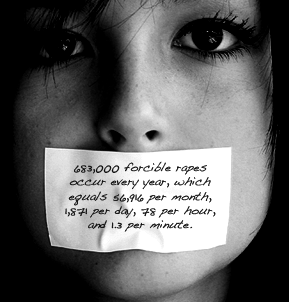by Melissa Campbell
There’s been a lot of talk about a recent New York Times article about a brutal gang rape of an 11-year-old girl in Texas. The article, which described the victim as wearing makeup and clothing more suited to a 20-year-old and quoted a member of the community worrying about the rapists saying “these boys will have to live with this for the rest of their lives,” has come under fire for blaming the victim for her own rape. The Times editor-at-large spoke out and sided with outraged readers and apologized that the article seemed much more concerned about the welfare of the rapists than the young victim.
Much of the conversation revolves around the fact that the 11-year-old victim liked wearing makeup, hanging out with older boys, was a flirt, wanted to be a porn star, and lacked parental supervision. Every single one of those “facts” is irrelevant, because an 11-year-old girl cannot legally consent to sex. I want to make it clear: Regardless of any “unseemly” or potentially sexual behavior, an 11-year-old girl cannot consent to sex, and thus this is a clear cut rape case. The End.
When we see a community accuse an 11-year-old girl of “asking” to be raped by 18 people because of makeup or clothing, we need to be outraged. But we don’t only need to be outraged because she’s 11 (though that’s obviously huge), we also need to be outraged because female victims of all ages come up against these exact same reactions every day. And they get it from everywhere: community members, police, lawyers, and judges–the very people who are supposed to keep assault victims safe. Instead, victims are asked questions like “what were you wearing?” as though what someone is wearing is somehow relevant to whether or not they consented to sex.
On at least three occasions, rapists have been acquitted because their victims’ skinny jeans were deemed “too tight” and according to the judges the victims would have had to have helped undress, which is apparently equal to consent. And early this year, a convicted rapist was allowed to walk free because the judge ruled that the victim’s tube top was “inviting,” and that “sex was in the air” the night of the attack. The judge referred to the attacker as a “clumsy Don Juan” and described the case as one of “misunderstood signals and inconsiderate behavior.”
All of these cases are connected: they assume that there is a “proper” way to be a victim of assault. According to the logic of these reactions and investigations, “real” victims of rape do not wear makeup. They don’t wear “provocative” clothing–not even tight jeans. They do not drink or flirt or go to parties. Women who DO wear tight clothes, drink or flirt–according to this logic–are not real victims.
This is an incredibly dangerous way of thinking. Victims are never to blame for their assaults. The only people who are responsible for rape are rapists. How come instead of saying “don’t get too drunk” to our daughters, we don’t say “don’t have sex with a passed out girl” to our sons? How come instead of telling girls they’re “asking for it,” why we don’t tell boys that NO ONE is ever asking to be raped?
In all these cases, there was more sympathy for the rapist than the victim. Citizens of Cleveland, Texas, worried out loud that the victim’s attackers “will have to live with this for the rest of their lives.” The judge in one of the skinny jeans cases worried that the attacker—who raped his 16-year-old driving student—would lose his job if found guilty. And the judge in the third case seemed quite concerned with preserving the assailant’s reputation. Somehow, these things take precedence over the well being of the victims.
I certainly hope these men will live with the crime for the rest of their lives. I certainly hope a rapist will lose the job that puts him in contact with more victims. And I certainly hope that one day in the future, when women report assaults, the first question won’t be “Well, what was she wearing?”
